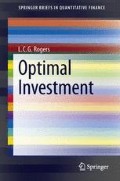Abstract
The first chapter of the book introduces the classical Merton problems of optimal investment over a finite horizon to maximize expected utility of terminal wealth; and of optimal investment over an infinite horizon to maximize expected integrated utility of running consumption. The workhorse method is to find the Hamilton-Jacobi-Bellman equations for the value function and then to try to solve these in some way. However, in a complete market we can often use the budget constraint as the necessary and sufficient restriction on possible consumption streams to arrive quickly at optimal solutions. The third main method is to use the Pontryagin-Lagrange approach, which is an example of dual methods.
Access this chapter
Tax calculation will be finalised at checkout
Purchases are for personal use only
Notes
- 1.
Commonly, some of the terms of the wealth equation may be missing; we often assume \(e \equiv 0\), and sometimes \(\delta \equiv 0\).
- 2.
The notation \(a\cdot b\) for \(a,b \in \mathbb R ^d\) denotes the scalar product of the two vectors.
- 3.
... since the Greek letter \(\theta \) corresponds to the English ‘th’.
- 4.
We require of course that the problem is well-posed, that is, the supremum is finite. We shall have more to say on this in Section 1.6.
- 5.
Notice that the value function \(V\) should be concave in \(w\), so \(V_{ww}\) will be negative.
- 6.
See Section 1.8.
- 7.
The requirement of non-positivity is stronger than absolutely necessary, but is imposed to guarantee that the problem is well posed. Without this, we would need to impose some rather technical growth conditions on \(u\) which would be distracting.
- 8.
Compare (1.20).
- 9.
... provided the integral is finite ...
- 10.
Recall that \(\beta >1\).
- 11.
... one which leads straight to (1.53) without the need to eliminate the spurious solutions to the homogeneous ODE ..
- 12.
We also require \(\sigma ^{-1}\) bounded.
- 13.
There is nothing to prevent us from having \(u(t,x) = u(\omega ,t,x)\), where \((\cdot ,\cdot ,x)\) is a previsible process for each \(x\); the arguments go through without modification.
- 14.
Compare this expression with (1.34).
- 15.
Since \(\kappa \) is bounded, the process \(Z\) is a martingale, by Novikov’s criterion.
- 16.
Arbitrage pricing theory only requires that discounted assets should be martingales in some risk-neutral measure, but under the complete markets assumption, there is only one. We do not actually require anything from arbitrage pricing theory here—everything is derived directly.
- 17.
... because of the strict concavity assumption ...
- 18.
See Rogers [31], Klein & Rogers [22], which apply deep general results of Kramkov & Schachermayer [23] to arrive at a result of this kind.
- 19.
The optimization over \(c\) only yields a finite supremum if \(\lambda _t \ge 0\), so this is a dual-feasibility condition on \(\lambda \). Notice that the optimizing \(c\) satisfies \(U^{\prime }(t,c_t) = \lambda _t\).
- 20.
We assume that \(\lim \nolimits _{t \rightarrow \infty } \lambda _tw_t = 0\), a transversality condition.
- 21.
That is to say, the supremum on the right-hand side of (1.18) defining the value function is finite for any \(w_0>0\).
- 22.
The argument that follows would be familiar to any trained economist; see, for example, the account of Breeden [5]. It is a principle, not a theorem, just like the Pontryagin-Lagrange approach; it leads us to useful conclusions and insights, but other methods are needed to confirm these in any given situation.
- 23.
Of course, it is possible that this perturbed consumption is not feasible; it could become negative at some point in \((s,s+h)\). We ignore such issues, as we may once we let \(\varepsilon \), \(h\) become infinitesimal.
- 24.
... under minor technical conditions ...
- 25.
... for example, supply and demand curves ....
- 26.
.. for simplicity; the entire analysis goes through with only notational changes if there are multiple assets, and indeed multiple goods.
- 27.
Thus \(\lim \nolimits _{x \downarrow 0} u^{\prime }(t,x) = \infty \), \(\lim \nolimits _{x \uparrow \infty }u^{\prime }(t,x) = 0\).
- 28.
Of course, the net supply of money need not be zero; we just suppose this for now, for the purpose of the discussion.
- 29.
We omit the superfluous index for the sole agent.
- 30.
This is a representative agent equilibrium; typically these things are easy to solve, but of limited interest because no interaction effects have been modelled.
- 31.
We use \(V_M\) to denote the value function of the Merton problem (1.30).
Author information
Authors and Affiliations
Corresponding author
Rights and permissions
Copyright information
© 2013 Springer-Verlag Berlin Heidelberg
About this chapter
Cite this chapter
Rogers, L.C.G. (2013). The Merton Problem. In: Optimal Investment. SpringerBriefs in Quantitative Finance. Springer, Berlin, Heidelberg. https://doi.org/10.1007/978-3-642-35202-7_1
Download citation
DOI: https://doi.org/10.1007/978-3-642-35202-7_1
Published:
Publisher Name: Springer, Berlin, Heidelberg
Print ISBN: 978-3-642-35201-0
Online ISBN: 978-3-642-35202-7
eBook Packages: Mathematics and StatisticsMathematics and Statistics (R0)

